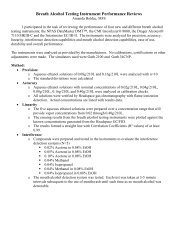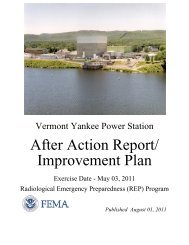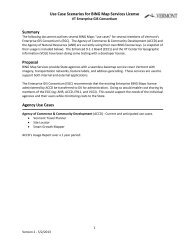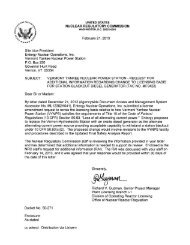3-1-2013 Letter from VY to NRC Plan for Reliable ... - State of Vermont
3-1-2013 Letter from VY to NRC Plan for Reliable ... - State of Vermont
3-1-2013 Letter from VY to NRC Plan for Reliable ... - State of Vermont
- No tags were found...
Create successful ePaper yourself
Turn your PDF publications into a flip-book with our unique Google optimized e-Paper software.
AREVA NP Inc. ANP-3203Revision 0<strong>Vermont</strong> Yankee Nuclear Power Station’s Overall Integrated <strong>Plan</strong> in Response <strong>to</strong> March 12, 2012Commission Order Modifying Licenses with Regard <strong>to</strong> Requirements <strong>for</strong> <strong>Reliable</strong> HardenedContainment Vents (Order Number EA-12-O5O)Page 14will support the required number <strong>of</strong> valve cycles. The SOVs are the only electricalcomponents required <strong>for</strong> valve functionality that are located inside the area considerednot-accessible following a prolonged 880. The AOVs do not require <strong>to</strong>rque switchesand limit switches <strong>to</strong> operate. The limit switches will only be used <strong>for</strong> position indication.Backup manual operation <strong>from</strong> the remote control station allows <strong>for</strong> opening the AOVswithout DC power by bypassing the SOVs and directly supplying nitrogen <strong>to</strong> the valveactua<strong>to</strong>rs.2. An assessment <strong>of</strong> temperature and radiological conditions that operating personnel mayencounter both in transit and locally at the controls will be per<strong>for</strong>med,3. All permanently installed HCVS equipment, including any connections required <strong>to</strong>supplement the HCVS operation during a prolonged SBO (electric power,N2/air) will belocated in areas reasonably protected <strong>from</strong> defined hazards <strong>from</strong> NEI 12-06.4. All valves required <strong>to</strong> open the flow path are designed <strong>for</strong> remote manual operationfollowing a prolonged SBO, i.e., no valve operation via handwheel, reach—rod or similarmeans that requires close proximity <strong>to</strong> the valve. Any supplemental connections will bepre-engineered <strong>to</strong> minimize manpower resources and any needed portable equipmentwill be reasonably protected <strong>from</strong> defined hazards <strong>from</strong> NEI1 2-06.5. Access <strong>to</strong> the locations described above will not require temporary ladders orscaffolding.6. A manual override motive gas system will be permanently installed <strong>to</strong> supply motive gas<strong>to</strong> the HCVS ClVs <strong>to</strong> address loss <strong>of</strong> power <strong>to</strong> the DC SOVs. The nitrogen pneumaticsupply will be connected in parallel with the existing pneumatic supply <strong>to</strong> manually cyclethe ClVs. The manual operation will be per<strong>for</strong>med <strong>from</strong> the remote control stationlocated in the accessible diesel genera<strong>to</strong>r room.Requirement 1.2.3 - Prevent Inadvertent ActuationThe HCVS shall include a means <strong>to</strong> prevent inadvertent actuation.ISG 1.2.3 Criteria:The design <strong>of</strong> the HCVS shall incorporate features, such as control panel key-locked switches, lockingsystems, rupture discs, or administrative controls <strong>to</strong> prevent the inadvertent use <strong>of</strong> the vent valves. Thesystem shall be designed <strong>to</strong> preclude inadvertent actuation <strong>of</strong> the HCVS due <strong>to</strong> any single active failure. Thedesign should consider general guidelines such as single point vulnerability and spurious operations <strong>of</strong> anyplant installed equipment associated withHCVS.The objective <strong>of</strong> the HCVS is <strong>to</strong> provide sufficient venting <strong>of</strong> containment and prevent long-termoverpressure failure <strong>of</strong> containment following the loss <strong>of</strong> active containment heat removal capability orprolongedSBC),Howeve,, inadvertent actuation <strong>of</strong> HCVS due <strong>to</strong> a design error equ,Øment malfunction, oropera<strong>to</strong>r error during a design basis loss-<strong>of</strong>-coolant accident (DBLOCA) could have an undesirable effect onthe containment accidentpressure (CAP) <strong>to</strong> provide adequate net positive suction head <strong>to</strong> the emergencycore cooling system (ECCS) pumps. There<strong>for</strong>e, prevention <strong>of</strong> inadvertent actuation, while important <strong>for</strong> allplants, is essential <strong>for</strong> plants relying on CAP. The licensee submittals on HCVS shall specifically includedetails on how this issuerequiredwill be addressed on their individual plants <strong>for</strong> all situations when CAP credit is






